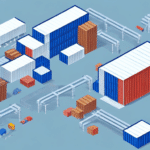In today's fast-paced business environment, optimizing logistics and operations is essential for achieving maximum efficiency and profitability. To achieve this, businesses need to streamline supply chain processes, utilize technology, implement lean principles, enhance communication, maximize inventory management strategies, minimize transportation costs, and much more. This article explores these critical factors in detail to help organizations achieve optimal performance and success.
Streamlining Supply Chain Processes for Improved Efficiency
Effective supply chain management is a cornerstone of operational excellence. By streamlining supply chain processes, businesses can reduce lead times, improve order accuracy, and eliminate waste. Key strategies include:
- Strategic Inventory Placement: Storing inventory in locations that minimize transportation time and costs.
- Real-Time Data Sharing: Utilizing platforms that allow for instant data exchange between stakeholders.
- Automation: Implementing automated systems to reduce manual data entry and associated errors.
According to a McKinsey report, companies that adopt advanced supply chain technologies can improve their efficiency by up to 20%.
Implementing Automation in Supply Chains
Automation plays a pivotal role in enhancing supply chain efficiency. Automated inventory management systems, for instance, enable businesses to track inventory levels in real-time, reducing the risk of stockouts and overstocking. This not only ensures optimal inventory levels but also enhances cash flow management.
Collaborative Supply Chain Management
Collaboration with suppliers and customers is crucial for streamlining supply chain processes. Utilizing collaborative software, such as supply chain management platforms, allows for real-time data sharing and improved communication, leading to reduced lead times and increased overall efficiency.
Utilizing Technology to Improve Logistics and Operations
Technology is integral to modern logistics and operations management. Advanced software solutions, tracking tools, and automation systems contribute significantly to operational efficiency. Key technologies include:
- Warehouse Management Systems (WMS): Optimize warehouse operations and inventory control.
- Transportation Management Systems (TMS): Enhance the efficiency of transportation operations.
- Data Analytics Tools: Provide insights for data-driven decision-making.
Utilizing technology not only improves accuracy and reliability but also enables businesses to gather and analyze data effectively. According to a study by Gartner, global spending on supply chain technology is projected to reach $1 trillion by 2024.
Enhancing Data-Driven Decision Making
Data analytics tools empower businesses to gain valuable insights into their operations. By analyzing operational data, companies can identify inefficiencies, forecast demand, and make informed decisions that lead to cost savings and improved customer service.
Implementing Lean Principles to Reduce Waste and Increase Efficiency
Lean principles focus on eliminating waste and optimizing processes to enhance efficiency and reduce costs. Applying lean methodologies can lead to significant improvements in various operational areas, including procurement, inventory management, transportation, and order fulfillment.
- Waste Reduction: Identifying and eliminating non-value-added activities.
- Continuous Improvement: Encouraging ongoing efforts to improve processes and products.
- Employee Involvement: Engaging all employees in identifying areas for improvement.
Fostering a Culture of Continuous Improvement
Involving all employees in the lean process fosters a culture of continuous improvement. Training and encouraging staff at all levels to identify waste and suggest improvements ensures that lean principles are sustained and effectively integrated into the organization's operations.
Enhancing Communication and Collaboration Across Departments
Effective communication and collaboration across departments are essential for operational excellence. Open communication channels help identify and address potential bottlenecks, improve decision-making, and enhance customer service.
- Regular Meetings: Facilitating consistent interaction among teams.
- Cross-Functional Teams: Promoting collaboration between different departments.
- Collaboration Tools: Utilizing software to streamline communication and project management.
Engaged and well-coordinated teams lead to higher productivity, better quality work, and lower employee turnover.
Leveraging Collaboration Software
Implementing collaboration tools like Slack or Asana can significantly enhance communication and project management across departments, ensuring that all teams are aligned and working towards common goals.
Maximizing Inventory Management Strategies for Optimal Performance
Effective inventory management is crucial for maintaining the balance between supply and demand. Optimizing inventory levels can lead to cost reductions, improved customer satisfaction, and enhanced operational performance.
- Just-In-Time (JIT) Inventory: Ordering inventory only when needed to reduce storage costs.
- Accurate Forecasting: Utilizing data analytics to predict future inventory needs.
- Automated Inventory Systems: Implementing systems that track inventory levels in real-time.
Implementing a JIT inventory system can improve cash flow by reducing the amount of capital tied up in inventory, as highlighted in a Harvard Business Review article.
Utilizing Data Analytics for Inventory Forecasting
Accurate forecasting using data analytics helps businesses anticipate demand fluctuations, ensuring that inventory levels are optimized to meet customer needs without overstocking.
Minimizing Transportation Costs through Efficient Route Planning and Carrier Selection
Transportation costs are a significant component of logistics expenses. Efficient route planning and strategic carrier selection can lead to substantial cost savings and improved delivery times.
- Route Optimization: Using software to determine the most efficient delivery routes.
- Carrier Evaluation: Selecting carriers based on their reliability, cost-effectiveness, and coverage.
- Real-Time Tracking: Implementing GPS tracking to monitor shipments and make adjustments as needed.
According to the U.S. Department of Transportation, effective route planning can reduce fuel consumption by up to 15%, leading to significant cost savings.
Selecting the Right Carrier
Choosing carriers that align with the specific needs of each shipment—such as specialized handling or regional expertise—can enhance delivery efficiency and reduce overall transportation costs.
Improving Customer Service by Optimizing Order Fulfillment Processes
Optimizing order fulfillment processes is essential for enhancing customer satisfaction. Streamlined order management leads to faster delivery times, higher accuracy, and better overall service quality.
- Automated Order Management Systems: Implementing systems that manage orders efficiently from placement to delivery.
- Data Analytics: Tracking order fulfillment metrics to identify and address areas for improvement.
- Quality Control: Ensuring orders are accurately picked, packed, and shipped.
Effective order fulfillment can reduce shipping costs and minimize returns due to errors, as supported by findings in a Forbes article.
Implementing Quality Control Measures
Quality control in order fulfillment ensures that customers receive the correct products in optimal condition, thereby increasing satisfaction and reducing return rates.
Balancing Cost Reduction with Quality Control Measures for Sustainable Operations
While reducing costs is important, maintaining quality is equally critical for long-term sustainability. Balancing these elements ensures that operational efficiencies do not compromise product or service standards.
- Lean Manufacturing: Applying lean principles to reduce waste without sacrificing quality.
- Sustainable Practices: Utilizing environmentally friendly materials and processes.
- Quality Assurance: Implementing robust quality control systems to maintain high standards.
Implementing lean practices can lead to cost savings while maintaining quality, as discussed in the Lean Enterprise Institute.
Using Sustainable Materials and Practices
Adopting sustainable materials and practices not only reduces environmental impact but also improves brand reputation among consumers who prioritize sustainability.
Measuring and Analyzing Key Performance Indicators to Identify Areas of Improvement
Key Performance Indicators (KPIs) are essential metrics that help businesses assess the effectiveness of their logistics and operations. By regularly measuring and analyzing KPIs, organizations can identify areas for improvement and implement corrective actions.
- Inventory Turnover: Measures how often inventory is sold and replaced over a period.
- On-Time Delivery: Tracks the percentage of orders delivered on or before the promised date.
- Order Accuracy: Assesses the correctness of orders fulfilled relative to customer specifications.
Selecting relevant KPIs aligned with business goals allows for targeted improvements. For example, a focus on reducing transportation costs may prioritize metrics like fuel efficiency and route optimization, as highlighted in a Supply Chain Brain article.
Setting and Monitoring KPIs
Establishing clear KPIs and regularly monitoring them enables businesses to track progress, identify trends, and make informed decisions that drive operational excellence.
Integrating Sustainability Practices into Logistics and Operations Strategies
Sustainability is increasingly becoming a critical component of logistics and operations strategies. By integrating sustainable practices, businesses can reduce their environmental footprint, comply with regulations, and enhance their brand reputation.
- Alternative Fuel Vehicles: Utilizing vehicles that run on renewable energy sources.
- Packaging Reduction: Minimizing packaging materials to reduce waste.
- Recycling Programs: Implementing recycling initiatives within operations.
Sustainable logistics practices not only benefit the environment but also lead to operational cost savings. A report by the United Nations highlights that sustainable practices can result in significant cost reductions and efficiency improvements.
Collaborating for Sustainability
Partnering with suppliers, customers, and other stakeholders to implement sustainable initiatives across the supply chain can amplify the impact of sustainability efforts and foster a more resilient business model.
Mitigating Risks and Ensuring Compliance in Logistics and Operations Processes
Logistics and operations management involve various risks, including supply chain disruptions, compliance violations, and product quality issues. Effective risk management and compliance strategies are essential for safeguarding business operations.
- Risk Management Programs: Developing comprehensive plans to identify, assess, and mitigate potential risks.
- Contingency Planning: Preparing alternative strategies to address unforeseen disruptions.
- Compliance Policies: Ensuring adherence to relevant regulations and industry standards.
Implementing robust risk management frameworks helps businesses navigate challenges and maintain operational continuity, as outlined in guidelines from the ISO 31000 standard.
Developing Comprehensive Risk Management Strategies
Creating detailed risk management strategies that encompass identification, assessment, and mitigation plans ensures that businesses are prepared to handle potential disruptions effectively.
Enhancing Workforce Training Programs to Improve Operational Efficiency
Investing in workforce training programs is vital for enhancing operational efficiency. Well-trained employees are more productive, make fewer errors, and contribute to higher quality outcomes.
- Training on New Technologies: Ensuring employees are proficient in the latest tools and systems.
- Best Practices: Educating staff on industry best practices to optimize performance.
- Safety Measures: Providing training to maintain a safe working environment.
Continuous training and development not only improve operational efficiency but also boost employee morale and retention, as supported by research from the Society for Human Resource Management.
Implementing Knowledge-Sharing Initiatives
Encouraging knowledge sharing among employees fosters a collaborative environment where best practices are disseminated, leading to collective improvements in operational processes.
Utilizing Data Analytics to Drive Decision-Making in Logistics and Operations
Data analytics is a powerful tool that enables businesses to make informed and strategic decisions in logistics and operations. By analyzing data, companies can identify patterns, assess performance, and uncover opportunities for improvement.
- Operational Efficiency: Using data to streamline processes and eliminate inefficiencies.
- Demand Forecasting: Predicting future demand to optimize inventory and supply chain operations.
- Performance Tracking: Monitoring key metrics to evaluate the effectiveness of operations.
Leveraging data analytics leads to better forecasting, inventory management, and distribution processes, ultimately driving cost savings and enhancing customer satisfaction. Insights from a datapine blog highlight the transformative impact of data-driven decision-making in logistics.
Implementing Advanced Analytics Tools
Adopting advanced analytics tools, such as machine learning and predictive analytics, can provide deeper insights into supply chain dynamics and operational performance.
Implementing Continuous Improvement Initiatives to Sustain Operational Excellence
Sustaining operational excellence requires a commitment to continuous improvement. Regular evaluation of supply chain processes and the implementation of improvement initiatives ensure that businesses remain competitive and efficient.
- Kaizen: A philosophy of continuous, incremental improvements.
- Six Sigma: A methodology focused on reducing defects and improving quality.
- Lean Practices: Streamlining processes to maximize value and minimize waste.
Continuous improvement initiatives help businesses adapt to changing market conditions and operational challenges, maintaining high standards of performance and efficiency. The iSixSigma platform provides extensive resources on implementing continuous improvement methodologies effectively.
Adopting a Continuous Improvement Mindset
Encouraging a mindset of ongoing evaluation and enhancement among employees fosters an environment where operational excellence is a shared goal, driving sustained improvements across the organization.
In conclusion, optimizing logistics and operations for maximum efficiency is critical for achieving success in today's competitive business environment. By implementing the strategies outlined above, businesses can improve operational efficiency, reduce costs, enhance customer satisfaction, and ensure sustainable operations.




















